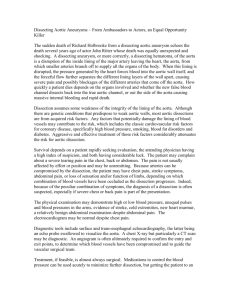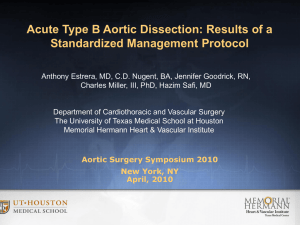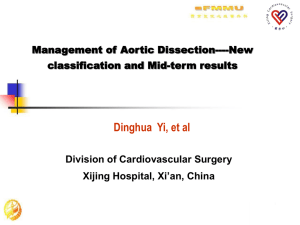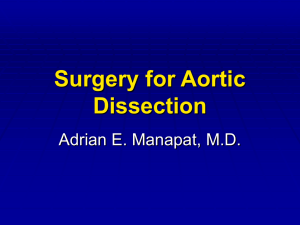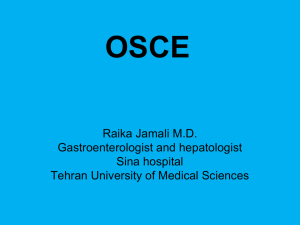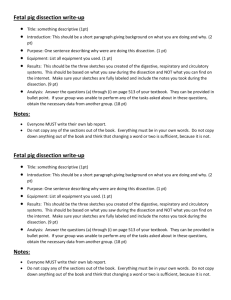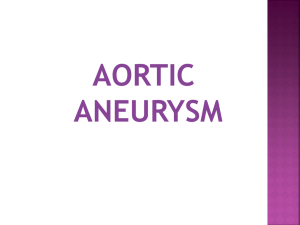Aortic Dissection Show Notes (Word Format)
advertisement
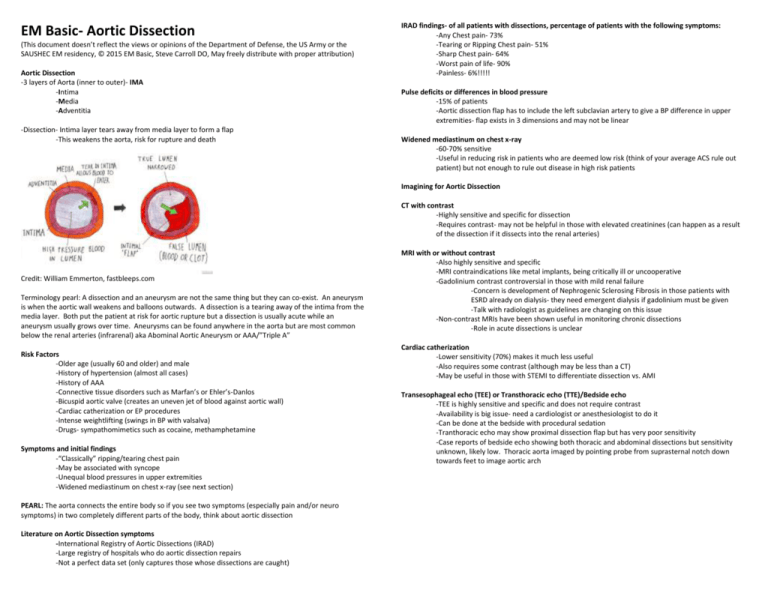
EM Basic- Aortic Dissection (This document doesn’t reflect the views or opinions of the Department of Defense, the US Army or the SAUSHEC EM residency, © 2015 EM Basic, Steve Carroll DO, May freely distribute with proper attribution) Aortic Dissection -3 layers of Aorta (inner to outer)- IMA -Intima -Media -Adventitia -Dissection- Intima layer tears away from media layer to form a flap -This weakens the aorta, risk for rupture and death IRAD findings- of all patients with dissections, percentage of patients with the following symptoms: -Any Chest pain- 73% -Tearing or Ripping Chest pain- 51% -Sharp Chest pain- 64% -Worst pain of life- 90% -Painless- 6%!!!!! Pulse deficits or differences in blood pressure -15% of patients -Aortic dissection flap has to include the left subclavian artery to give a BP difference in upper extremities- flap exists in 3 dimensions and may not be linear Widened mediastinum on chest x-ray -60-70% sensitive -Useful in reducing risk in patients who are deemed low risk (think of your average ACS rule out patient) but not enough to rule out disease in high risk patients Imagining for Aortic Dissection CT with contrast -Highly sensitive and specific for dissection -Requires contrast- may not be helpful in those with elevated creatinines (can happen as a result of the dissection if it dissects into the renal arteries) Credit: William Emmerton, fastbleeps.com Terminology pearl: A dissection and an aneurysm are not the same thing but they can co-exist. An aneurysm is when the aortic wall weakens and balloons outwards. A dissection is a tearing away of the intima from the media layer. Both put the patient at risk for aortic rupture but a dissection is usually acute while an aneurysm usually grows over time. Aneurysms can be found anywhere in the aorta but are most common below the renal arteries (infrarenal) aka Abominal Aortic Aneurysm or AAA/”Triple A” Risk Factors -Older age (usually 60 and older) and male -History of hypertension (almost all cases) -History of AAA -Connective tissue disorders such as Marfan’s or Ehler’s-Danlos -Bicuspid aortic valve (creates an uneven jet of blood against aortic wall) -Cardiac catherization or EP procedures -Intense weightlifting (swings in BP with valsalva) -Drugs- sympathomimetics such as cocaine, methamphetamine Symptoms and initial findings -“Classically” ripping/tearing chest pain -May be associated with syncope -Unequal blood pressures in upper extremities -Widened mediastinum on chest x-ray (see next section) PEARL: The aorta connects the entire body so if you see two symptoms (especially pain and/or neuro symptoms) in two completely different parts of the body, think about aortic dissection Literature on Aortic Dissection symptoms -International Registry of Aortic Dissections (IRAD) -Large registry of hospitals who do aortic dissection repairs -Not a perfect data set (only captures those whose dissections are caught) MRI with or without contrast -Also highly sensitive and specific -MRI contraindications like metal implants, being critically ill or uncooperative -Gadolinium contrast controversial in those with mild renal failure -Concern is development of Nephrogenic Sclerosing Fibrosis in those patients with ESRD already on dialysis- they need emergent dialysis if gadolinium must be given -Talk with radiologist as guidelines are changing on this issue -Non-contrast MRIs have been shown useful in monitoring chronic dissections -Role in acute dissections is unclear Cardiac catherization -Lower sensitivity (70%) makes it much less useful -Also requires some contrast (although may be less than a CT) -May be useful in those with STEMI to differentiate dissection vs. AMI Transesophageal echo (TEE) or Transthoracic echo (TTE)/Bedside echo -TEE is highly sensitive and specific and does not require contrast -Availability is big issue- need a cardiologist or anesthesiologist to do it -Can be done at the bedside with procedural sedation -Tranthoracic echo may show proximal dissection flap but has very poor sensitivity -Case reports of bedside echo showing both thoracic and abdominal dissections but sensitivity unknown, likely low. Thoracic aorta imaged by pointing probe from suprasternal notch down towards feet to image aortic arch Classification system- Stanford class A and B -All should be at a center that is capable of aortic repair- transfer if necessary -Class A- involvement of any section of the aortic arch proximal to the left subclavian -Treatment is surgical after rapid HR and BP control -Class B- no involvement of any section of the aortic arch -Aggressive medical management -May go to OR if it gets worse- importance of transfer Nitroprusside -Use once HR is under 60 BPM If systolic BP is still over 100 -0.25 – 0.5 mcg/kg/min IV -Avoid in renal failure patients Other options -Diltiazem/Verapamil after HR control -Nicardipine- After HR control PEARL: Proper loading of Nicardipine -Start at 5 mg/hr -Check BPs every 2-5 minutes -Increase drip by 2.5 mg/hr until you reach target or 15 mg/hr -Once at target, you have now loaded them with nicardipine -Drop drip to 3 mg/hr and re-titrate up slowly -If you leave patient on the initial rate, they will bottom out their pressure PEARL: If patients have severe chronic hypertension (always 180 SBP at clinic visits)- lower their BP as their mental status will allow. If they get lightheaded at a SBP of 140, stop there and titrate to AAOx3 Hypotensive patients -Be on the look out for a dissection that is causing pericardial tamponade -Diagnose with bedside ultrasound, be ready for urgent/emergent pericardiocentesis if necessary Treatment- Double Product Control (HR then BP) -Goal is to drop heart rate below 60 BPM THEN drop systolic BP below 100 -This prevents reflex tachycardia from dropping BP first -Each heart beat is another hammer on the dissection flap that can make it grow, goal is reduce the number of heartbeats that does this damage then reduce the pressure behind it. First- PAIN CONTROL!! -Good pain control will greatly bring down the BP -Fentanyl 75-100 mcg IV, morphine or dilaudid for longer acting pain control -Ketamine?- may increase HR and BP but may spare opiates in long run and get you down to your BP goal faster (in theory- no evidence for this)- very small doses 10-20mg at a time Heart Rate control- Look up these drugs since you don’t use them a lot! Don’t guess! Esmolol -Beta blocker, very short acting -Start: 500 mcg/kg IV loading dose -Titrate drip by 50 mcg/kg up to 200 mcg/kg/min -IMPORTANT: You must re-bolus starting bolus with each increase in the drip rate or you will not have any effect because it is so short acting. Labateolol -Beta blocker with alpha-1 blocker properties as well -Start 20mg IV -Re-bolus 10-80mg IV every 10 minutes in stepwise fashion -Example- 10, 20, 30, 40, etc. -Drip- 0.5-2 mg/min -Not as titratable as esmolol but much easier for your nurses to execute (less intensive) D-dimer to rule out dissection?- Unforuntately, no -Since dissections usually cause some amount of clot, thought was that we could use d-dimer the same way we use it in ruling out PE in low risk patients -Unfortunately, data at this time does not support that strategy- too many false positives and some false negative as well Patients with STEMI -Only 0.1% of STEMIs are found to have aortic dissection -Your job is to make sure to consider this diagnosis (and all others) while everyone else loses their minds with getting the patient to the cath lab -If the history is suspicious for dissection, get a chest x-ray and talk with cardiologist. Tell them you are suspicious for a dissection and will not give them heparin until they shoot their arch in the cath lab to check for a dissection Contact- steve@embasic.org; Twitter: @embasic

